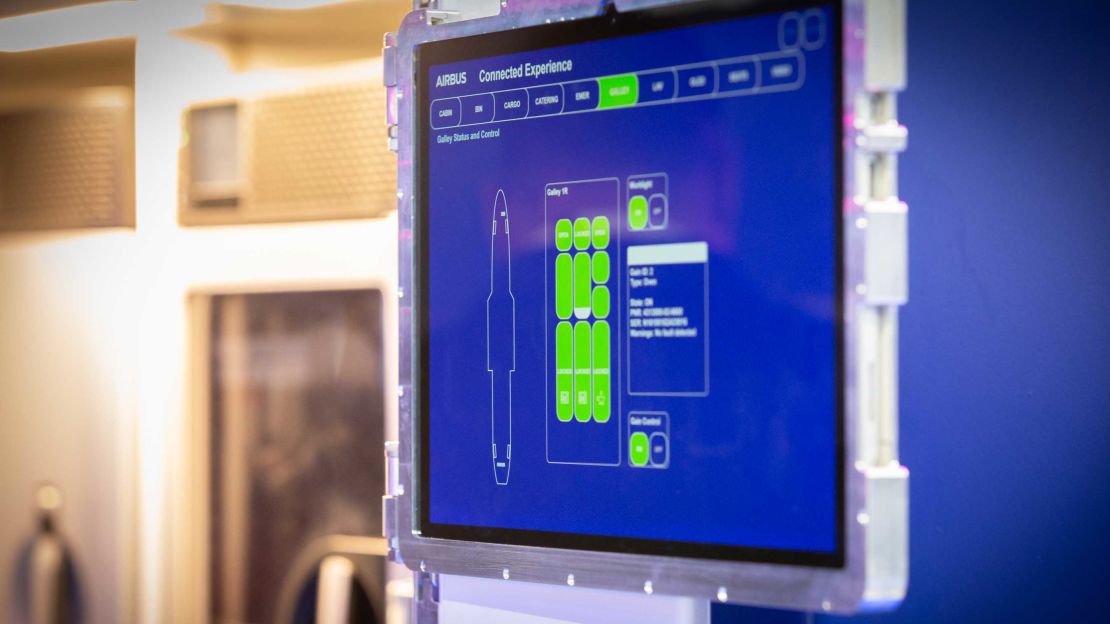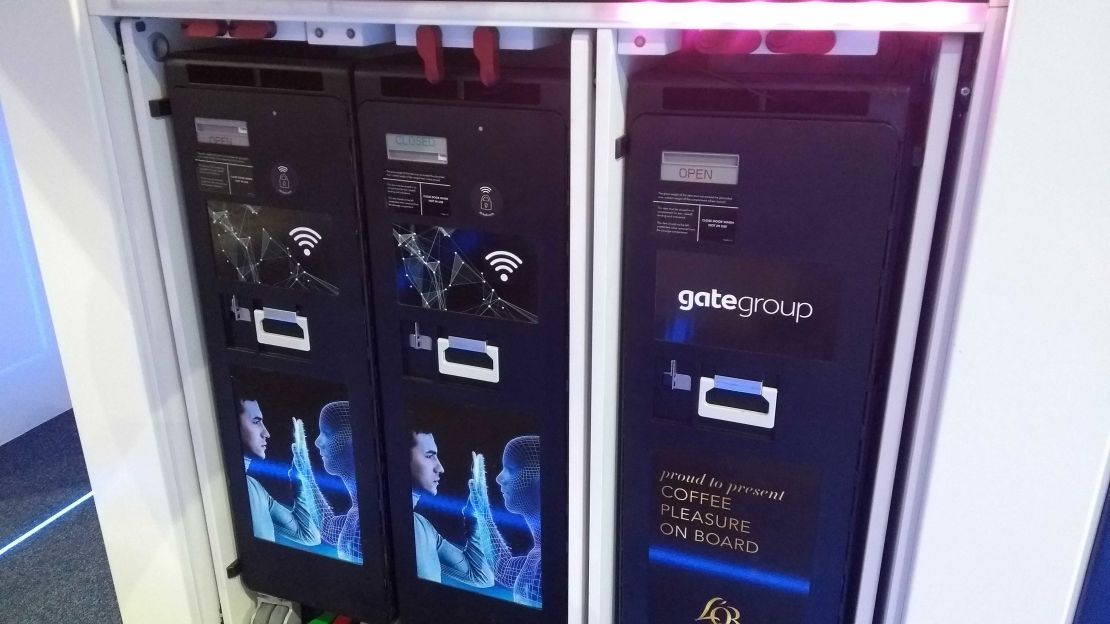Overhead luggage bins that illuminate in red when they’re full, an airplane seat tailored to your personal position preferences, seat belts that alert cabin crew when they’re unbuckled.
And cameras outside restrooms.
This, according to Airbus, is what the airplane cabin of the very near future will look like.
The European aerospace company recently announced inflight trials of what it calls its Airspace Connected Experience cabin at an industry event in Los Angeles.
But while some of its passenger-focused innovations may well emerge as super convenient, others such as the restroom cameras are likely to further ignite debate over passenger privacy in the skies.
Airbus says the connected cabin is the natural extension of the ultra-connectivity many of us experience on the ground – from smart homes to the ubiquitous Amazon Alexa and Google devices, to cellphones that predict our every move.
“It’s a kind of a seamless transfer,” Ingo Wuggetzer, VP marketing at Airbus, tells CNN Travel. “What you experience on ground, you continue to experience on board of an aircraft.”
Wuggetzer says Aibrus’s new concepts will make boarding quicker, allow cabin crew to be constantly on the ball and cater to the intrinsic desires of a 21st century airplane passenger.
He dismisses potential fears about airlines gathering ever more data on their passengers.
“I think today’s airlines have a lot of data already about their frequent fliers, and usually frequent fliers see the benefit of a more personalized service.”
Data driven

So how does the new cabin concept work? Wuggetzer says the cabin’s outfitted with a “connected experience backbone” grounded in wireless technology.
“It’s controlled mainly by the crew with a portable device,” he says. Passengers will also be able to sync up their personal devices to this “backbone.”
When passengers board, they’ll see an OLED Welcome panel, that, Wuggetzer says, could provide updates throughout the journey.
The connected airplane seat will be pre-programmed with passenger seat reclining preferences, personalized inflight entertainment (IFE) and catering preferences.
It’s not just convenient, says Wuggetzer, but it also allows for a more seamless and sustainable travel experience.
“If you only cater the preferred meal for that passenger, you do not need to over cater anymore,” says Wuggetzer.
Cabin crew will be able to facilitate speedier boarding thanks to overhead luggage cabins that’ll light up green or red, depending on whether they’re full.
Crew will no longer need to patrol the cabin, checking every passenger’s seat is upright, armrest is down and seat belt is buckled.
“This, you can check by a sensor,” says Wuggetzer.
Camera concerns

Cameras on airplanes is a contentious topic in the aviation industry. Fears about privacy were raised earlier in 2019 when several major carriers admitted there were cameras installed in their IFE systems.
Airlines, including Singapore Airlines and Emirates, stressed the cameras were deactivated and they had no plans to turn them on without passenger consent.
Nevertheless, fliers have expressed concerns about data collection while security experts have raised fears about hacking.
Wuggetzer is keen to disassociate the cameras on board the Airbus Connected Experience cabin with the IFE controversy.
He also wants to dissipate passenger concerns about where the cameras are located.
“First they are not hidden,” he says. “And secondly, they are in front of the lavatories.”
Wuggetzer also says that the cameras will be installed with a filter that blurs out faces.
The aim, he says, isn’t to collect data on how long passengers spend in the restroom, but rather to help redirect foot traffic if there are long lines, and also to monitor how much toilet roll or soap is available inside and whether it needs a top up.
An alert will be sent to the crew if it appears a passenger is spending an unusually long time in the restroom.
“This information might go to the crew – but it’s completely decoupled from any personal passenger information,” says Wuggetzer.
“It’s an anonymous solution. And this should help the passengers to find the fastest way to the lavatory.”
In general, Wuggetzer seems a bit bemused at the fears surrounding restroom cameras.
“Lavatories, I don’t know why everybody talks about lavatories?” he says. “I think there has been some misunderstanding.”

Still, some have voiced concerns about the connected cabin, including travel journalist and family travel expert Candyce H. Stapen, who called the concept a “privacy invasion” on Twitter.
“When I purchase an airline ticket […] I am not signing up to be part of a tracked experiment for the airline company,” Stapen, a frequent flier who says she’s accrued nearly two million miles on American Airlines alone, tells CNN Travel.
“With the Airbus new system, I won’t have a choice,” she adds. “That in itself seems to be a type of privacy invasion, as is tracking when and how often I or anyone else uses the bathroom.”
Stapen is also skeptical about the need for cameras monitoring restroom lines and worries about the consequences of a more high-tech cabin.
“I find it hard to believe that tracking was initiated to benefit passengers,” she says. “I can see the technology resulting in even fewer flight attendants per flight if the airlines can legally get away with reducing numbers.”
Aviation consultant Peter Lemme tells CNN Travel that, while the objectives of Airbus’s cabin concept appear positive, he also has concerns about potential privacy implications of on-board data collection and cameras in cabins and questions how far the surveillance will extend.
“A tracking algorithm can easily associate a human ‘blob’ to a seat and follow them as they move about the cabin freely,” says Lemme. “We have to rely on promise, policy and procedure.”
But Vitaly Kamluk, a malware expert who kickstarted debate over seatback cameras with a Tweet to Singapore Airlines earlier this year, says he views cameras outside airplane bathrooms as very different to hidden cameras in IFE systems.
“[The] airplane cabin is not anyone’s private space, it’s a public zone,” he tells CNN Travel. “It can and should be monitored according to the best public security and safety standards. I do not see any privacy violations by doing this.”
Transparency from airlines, he says, would be key.
“To mitigate potential privacy issues the company has to display clear warning signs and mark the camera location, so that it would be visible to all the passengers.”
Trials begin
Airbus has commenced in-flight trials of the connected technology and they’ll feed results back to carriers, who’ll then have the option of picking and choosing different aspects of the connected cabin for their aircraft, depending on their needs.
Wuggetzer stresses that the camera concept is just one option offered to airlines, who’ll be able to assess what’s offered by the Airbus concept and pick what works for them.
The plan is for the concept to enter into service for single aisle aircraft in 2021 and for wide body aircraft by 2023.
The concept has already got the industry seal of approval: at the Aircraft Interiors Expo in Los Angeles in September 2019, the Airspace Connected Experience won a 2019 Crystal Cabin Award for “Best Customer Journey.”





